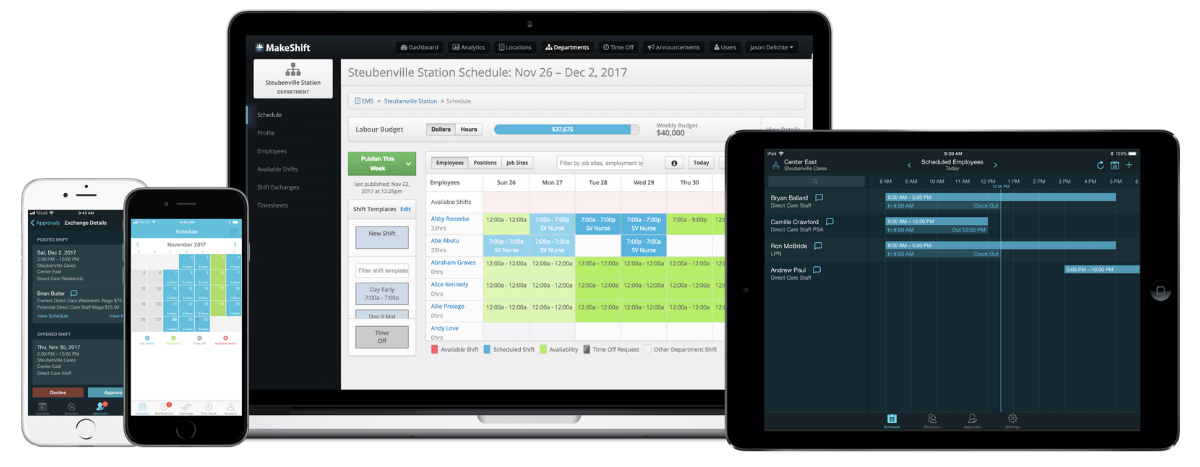You've heard the saying, “An organization is only as good as its people.”
Truer words have yet to be spoken.
This spot-on statement spotlights the critical role employee engagement plays in your company.
It’s more than making your staff happy.
It's about nurturing an environment where team members feel valued, heard, and empowered.
Employee engagement is a cornerstone for building a successful business. The aim is to create a culture where each employee feels like they’re a part of your company's success.
From practical strategies to real-world examples, we’ll explore how fostering a sense of value and empowerment can increase productivity, retention, and overall business growth.
Today you’ll learn how to transform your workforce into a more engaged, motivated, and committed entity.
- Employee Engagement — What Is It & Why It’s Important
- 3 Levels of Employee Engagement
- How to Measure Employee Engagement
- 11 Strategies to Improve Employee Engagement
- How to Upgrade Employee Engagement with MakeShift
- FAQs about Employee Engagement
What Is Employee Engagement?
Employee engagement refers to the level of commitment, passion, and loyalty an employee has toward their work and company. It’s summed up in how motivated your employees feel about contributing to your company’s success.
Your employees need to feel part of a bigger picture beyond just clocking in and out.
Why is employee engagement essential?
High employee engagement leads to more productivity, higher retention rates, and happier, more passionate employees.
Think of employee engagement as the secret sauce that makes a workplace thrive. When employees are engaged, they're not just showing up to do their job until it’s time to head home.
They're really into their work, care about what they're doing, and feel like they're part of something bigger.

Studies have shown that companies with highly engaged employees have a 31% lower turnover rate and increased employee loyalty.
Here are 5 benefits of having highly engaged employees:
1. Better Performance — Engaged employees are your high-performing A-Team. They’re passionate about their job and go the extra mile to deliver higher-quality work.
2. Happier Team — When employees are engaged, they're generally happier. A happy team means a more positive and productive work vibe.
3. Less Turnover — Employees who love what they do and where they work are less likely to leave. This saves significant time and money in hiring and training new people.
Highly engaged employees contribute to 21% higher profitability. The teams who score in the top 20% in engagement have 41% less absenteeism and 59% less attrition.

4. Good Vibes for Customers — Customers feel it when employees are happy and engaged. This improves customer service and can draw in more business simply through word of mouth.
5. Innovative Ideas — Engaged employees often feel more comfortable sharing their ideas, leading to innovation and collaboration.
3 Levels of Employee Engagement
When measuring how engaged your employees are, keep in mind it’s not black and white.
There are levels of engagement — before you try to measure or improve it, you need to understand the degrees of engagement.
1. Highly engaged employees
These team members are your brand champions. They’re passionate about their work, talk up the company, and encourage other employees around them to bring their A-game.
2. Disengaged employees
These people are your “coasters.” They’ll do the bare minimum but won’t ask for more responsibilities and will probably underperform. These are also known as “Quiet Quitters.”
Time theft may be an issue with this type of employee.
3. Actively disengaged employees
These employees exude negative vibes all day and are too busy acting out their unhappiness to get much work done. They don’t care about your organization's mission, goals, and future.
Since they’re so unhappy, you’d think they’d be actively job searching, but these employees tend to stick around and poison morale.
U.S. Companies lose between $450-$550 billion each year due to disengaged workers. Just 1 disengaged employee can cost you almost $3,400 in lost productivity for every $10,000 in salary.
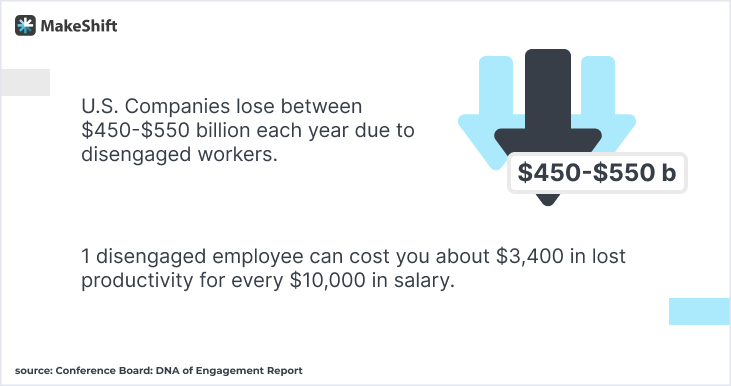
How to Measure Employee Engagement
Accurately measuring employee engagement is Step #1 toward improvement. You’ve got to know where your organization currently stands so you can identify areas for improvement.
Because you can’t fix something until you know where it’s broken.
Using a mix of quantitative and qualitative methods gives you the whole story of your employees' engagement levels.
This data-driven approach helps you make smart decisions and tailor strategies to amp up engagement where it counts.
1. Tools & Methods for Assessing Engagement
Use a variety of tools and methods to gather comprehensive data to get an in-depth view of your current overall engagement level.
- Employee Surveys — These are the most common tools and can be annual, bi-annual, or even quarterly. Include questions about these aspects of their job and your company:
- Satisfaction
- Communication
- Company Culture
- Leadership
- Staff scheduling
- Work-life balance
SurveyMonkey works well for these surveys. If you choose to do quarterly surveys, you may want to use Likert scale questions (e.g., from strongly agree to disagree strongly) rather than open-ended questions to encourage employee participation. - One-on-One Interviews — Personal interviews can provide deeper insights.
They’re helpful for understanding individual employee experiences and can uncover issues that surveys might miss.
Consider conducting monthly or quarterly check-in interviews with employees to encourage openness. - Focus Groups — Gather diverse groups of employees to discuss specific topics. This method can help identify common themes and areas of concern.
Hold a focus group to discuss effectiveness after any recent changes in management or workflows.
2. Interpret Engagement Data
Once you've collected data, the next step is to analyze and interpret it to identify areas needing attention.
- Analyze Survey Results — Collecting data is good. What you do with it moves the needle on improving employee engagement. Look for trends, patterns, and areas with exceptionally high or low scores.
For example, if most employees report low satisfaction with communication, you know this area needs immediate attention. - Interview & Focus Group Feedback — Qualitative data from interviews and focus groups can provide context to the quantitative survey data.
Let’s say several employees mention feeling unrecognized. It’s time to revamp your recognition program.
11 Strategies to Improve Employee Engagement
You’ve got the skinny on what affects employee engagement and how to measure it.
Now it’s time to get proactive with these 11 strategies to improve your engagement. We’ve provided real-life examples of companies killing it with employee engagement efforts.
1. Foster Communication & Collaboration
Encourage open-door policies where employees feel comfortable sharing ideas and concerns with management. Adopt communication channels that make collaboration easy.
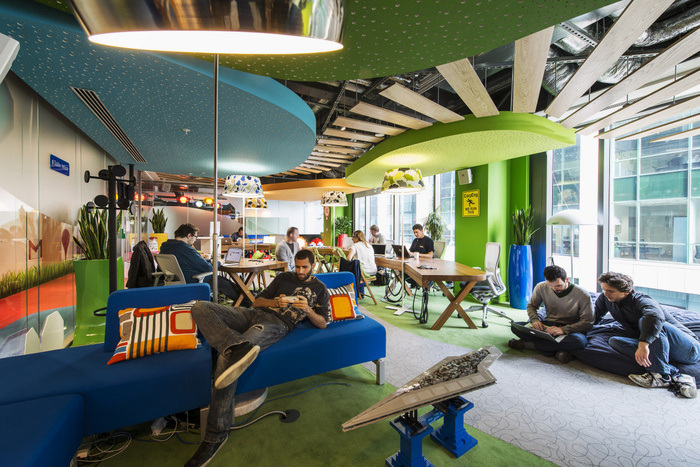
Since the beginning, Google has set the standard for exceptional internal communication and collaboration. Employees are encouraged to share ideas and thoughts freely.
They encourage communication between employees of any level rather than using a hierarchy of rank.
To facilitate this, Google uses multiple communication channels, including:
Gmail, Google Meet, Google Chat, and Google Voice.
2. Recognize and Reward Employees
Develop a recognition program that celebrates both big achievements and small wins. Offer personalized rewards that resonate with employees' interests and needs.
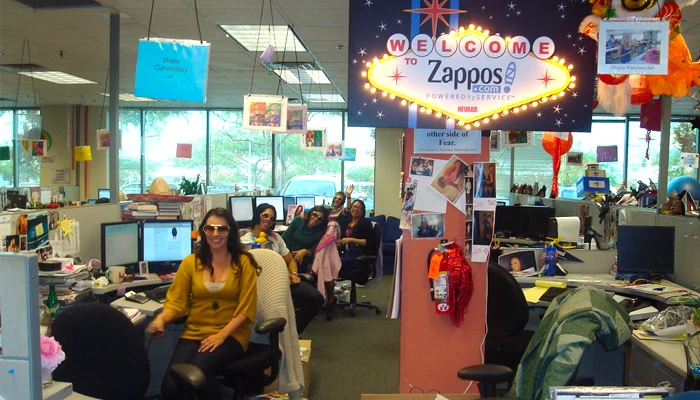
Zappos takes peer-to-peer recognition to an elevated level of WOW. Here are 3 elements of their recognition program:
- Each employee gets to give a $50 reward to any other employee for doing a great job.
- Employees can dole out “Zollars” (Zappo Dollars) when a co-worker amazes them. These Zollars can be redeemed in the Zappo store for water bottles, USB hubs, water guns, and even a charcoal grill.
- Based on submitted statements from the co-worker bonuses, a panel selects a “Hero of the Month” and “Sidekicks.”
- The Hero of the Month gets a $250 Zappos gift card or their choice of an experience (think ziplining or luxury car driving), a reserved Hero parking spot, a cape, and a pin.
- 3 Sidekicks each get a reserved parking spot, a $50 Zappos E-gift card, and a sidekick cape.
3. Provide Opportunities for Professional Growth
Create clear career paths and offer mentorship programs. Invest in training and development programs that help employees build new skills and advance their careers.

Walgreens encourages employees to pursue career development and educational opportunities through Walgreens University.
An employee can pursue becoming a certified pharmacy technician or go through the School of Operations to train to become a store manager. Many of their programs count toward college credit.
They’ve also partnered with universities nationwide to offer their employees tuition discounts.
4. Prioritize Work-Life Balance
Introduce flexible working arrangements, such as remote work options and flexible hours. Adopt staff scheduling software to give employees more say in their schedules.
Develop a culture that respects personal time and discourages overworking.

At Patagonia, workers set their own hours. They offer 15 different schedules for warehouse employees and guaranteed schedules up to 3 weeks in advance for retail employees.
There’s a child-care center on campus, and if a breastfeeding mother needs to take a business trip, they foot the bill for the mother, baby, and nanny.
If an employee needs to take time off in the middle of the day for a school pickup run or because the swells are enormous, they’re free to do that.
The company has sky-high retention rates and fiercely loyal employees because of their priority on balance.
5. Create a Positive Work Culture
Design a workspace that encourages collaboration and comfort. Organize team-building activities and social events to build a sense of community.
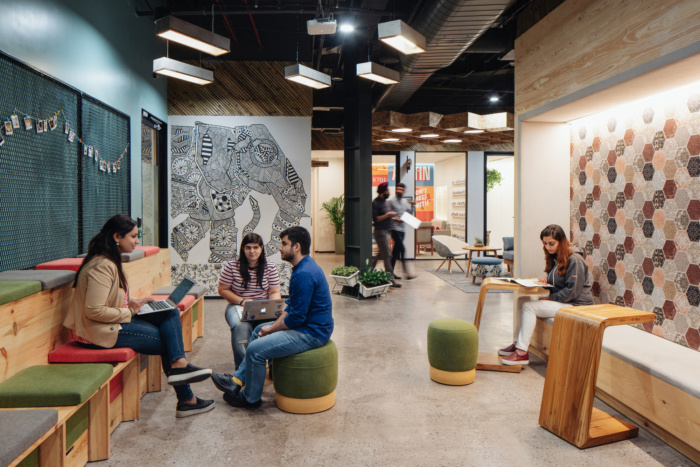
Airbnb has built its work culture around the idea of community. They offer an environment that welcomes innovation and outside-the-box thinking.
Airbnb’s offices are designed to be comfy and foster open team collaboration.
Their perks include free meals and snacks, paid volunteer time, and generous family leave benefits in addition to competitive salaries and health benefits.
6. Encourage Innovation
Foster continuous education by offering access to online courses, workshops, and seminars relevant to employees' roles and interests.
Cultivate an environment where creativity is valued and employees are encouraged to throw out ideas.
You can do this through innovation challenges, brainstorming sessions, and supporting personal projects that align with the company's goals.

One of Squarespace’s core values is “Protect Creativity,” and it shows. They have a bi-annual Hack Week, where employees at all levels can dig into their creativity by freeing themselves to work on anything they want for a week.
Squarespace also holds an annual Design Week to nurture creativity and innovation in product design and user experience.
7. Involve Employees in Decision Making
Implement suggestion boxes or regular surveys where employees can contribute ideas. Include employees in discussions about changes that affect their work or the workplace.

Wegman’s Food Markets is one of the largest privately owned food markets in the U.S., with over 110 stores across the Northeast and Mid-Atlantic. They pride themselves on being an “employee-first organization.”
They welcome employees' ideas and get them involved in the daily operations of the business. They arm their staff with the knowledge to help make informed decisions and elevate their job performance.
Deli workers are sent on trips to France, Italy, Germany, and Wisconsin to learn about cheese, while butchers are sent to Colorado and South America to learn about beef.
8. Emphasize Employee Well-Being
Offer wellness programs that focus on mental, physical, and emotional health. In addition, provide resources like counseling services, health workshops, and fitness activities.
Implement flexible staff scheduling options that prioritize your employees’ well-being and prevent under or overstaffing. Offer options like:
- Self-scheduling
- Hybrid work
- Flex-hours

Synchrony, a financial services company, employs well-being coaches who partner with employees to tailor a wellness strategy based on strengths and values.
They offer workers flexibility and choice on how, when, and where they work.
Synchrony also provides flexible scheduling options to support frontline associates’ needs better. They implemented Flex Fridays, where scheduling morning meetings is discouraged, and employees are nudged to take the afternoons for enrichment, learning, or personal time.
9. Engage Employees With Tech
Use collaborative tools and platforms to enhance teamwork and communication.
Introduce gamification elements in training or reward systems to make work more engaging.
Use staff scheduling software to streamline scheduling and make it more interactive for your employees.

Ormat Technologies, a renewable energy supplier, doubled down on employee engagement by adopting SAP SuccessFactors to provide employees with personalized content.
They use this system to deliver relevant news and announcements, learning opportunities, and surveys. They also use staff scheduling software to manage schedules from remote plant locations easily.
10. Build Trust and Integrity in Leadership
Train leaders and managers in emotional intelligence and effective communication. Ensure management actions align with your company's values and promises.
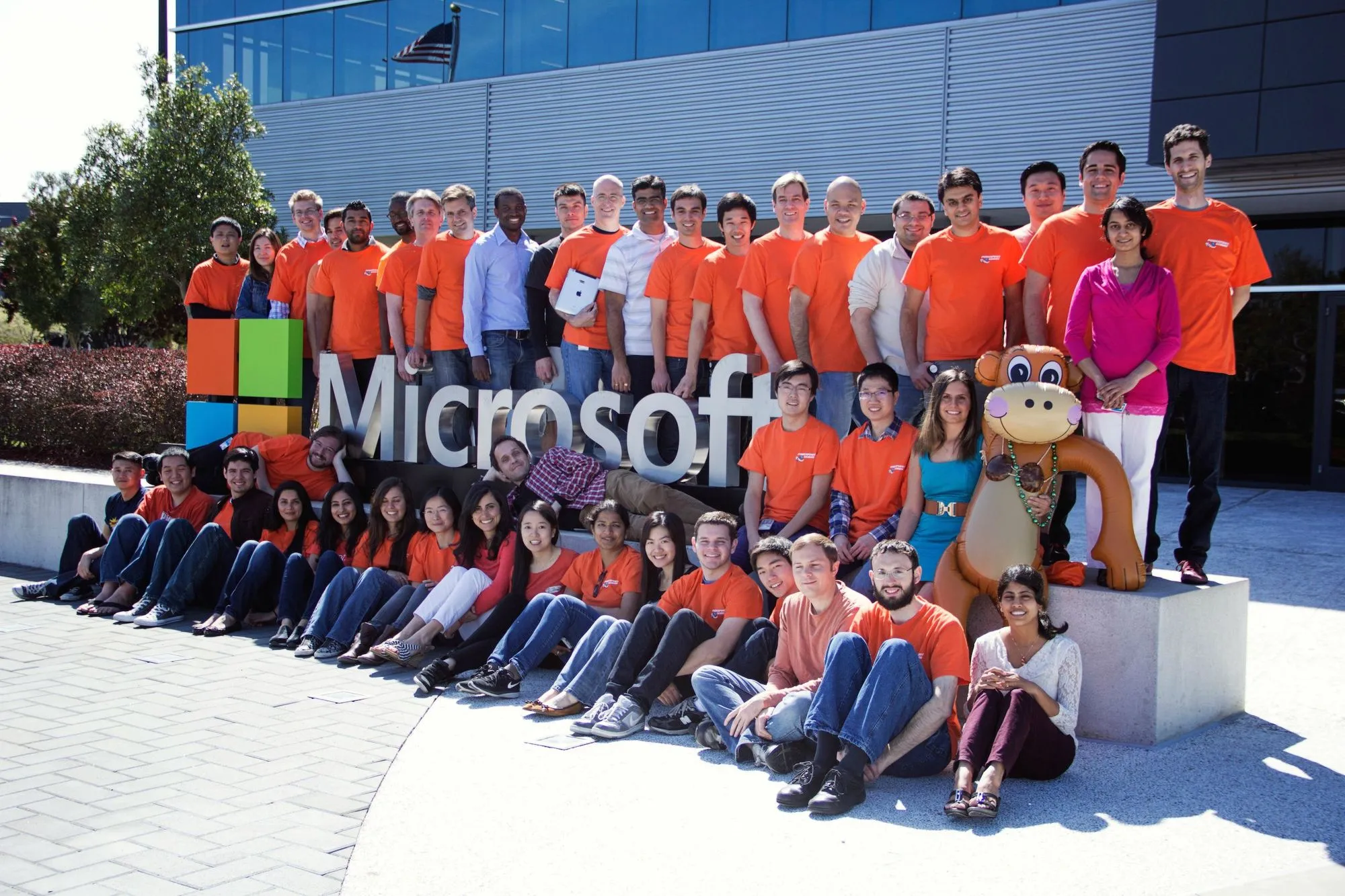
Microsoft’s senior leadership and management development centers around instilling a "growth mindset" culture.
The program also introduces a management framework called "Model, Coach, Care," which teaches managers how to interact successfully with their employees.
This framework has helped managers strengthen relationships with their teams and deliver more success through empowerment and accountability.
11. Customize Engagement Approaches
Recognize that different employees may have different engagement drivers and tailor your approaches accordingly. Regularly seek feedback on engagement initiatives and be willing to adapt strategies as needed.
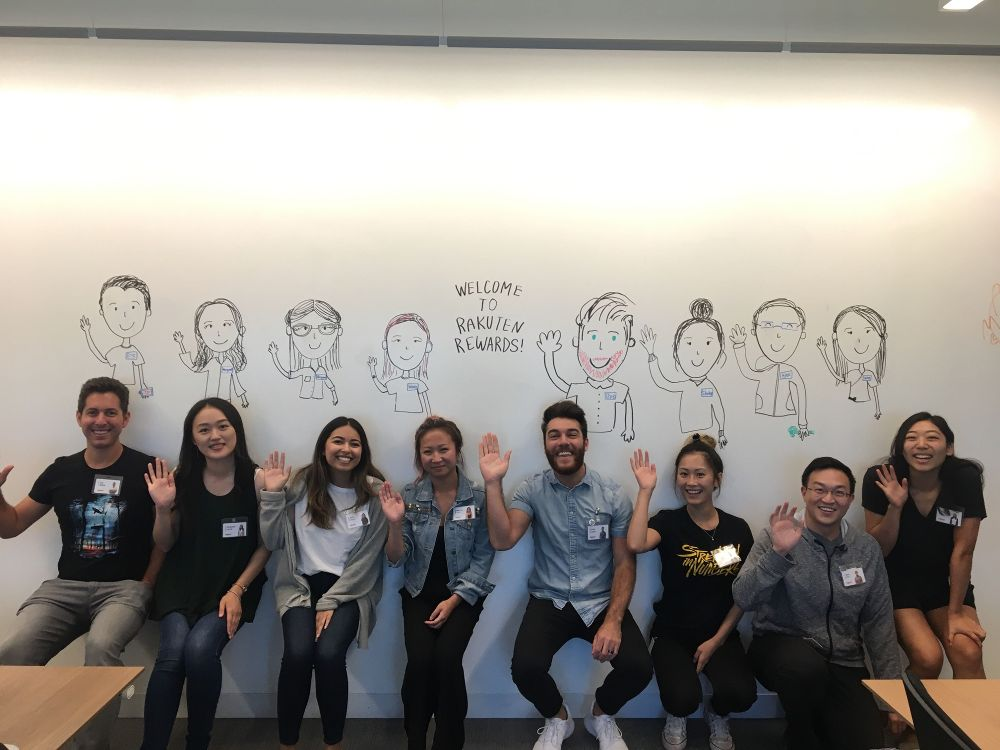
Rakuten has more than 70 businesses ranging from online to offline businesses like banking and travel, and over 28,000 employees across all businesses.
They’ve used software to offer varied benefits to appeal to the unique individuals on their team. Some of the perks they offer to keep employees engaged include:
- Corporate gym memberships
- Relocation support
- Stock options
- Talent development programs
How to Upgrade Employee Engagement with MakeShift
MakeShift goes beyond staff scheduling — it enhances workforce optimization by streamlining scheduling and encouraging communication.
Our cutting-edge technology makes scheduling more interactive and positively impacts recruitment, retention, and employee engagement.
These are our favorite features for improving employee engagement:
- Employees can easily set and manage their availability or request time off.

- They can swap shifts right from their phones.
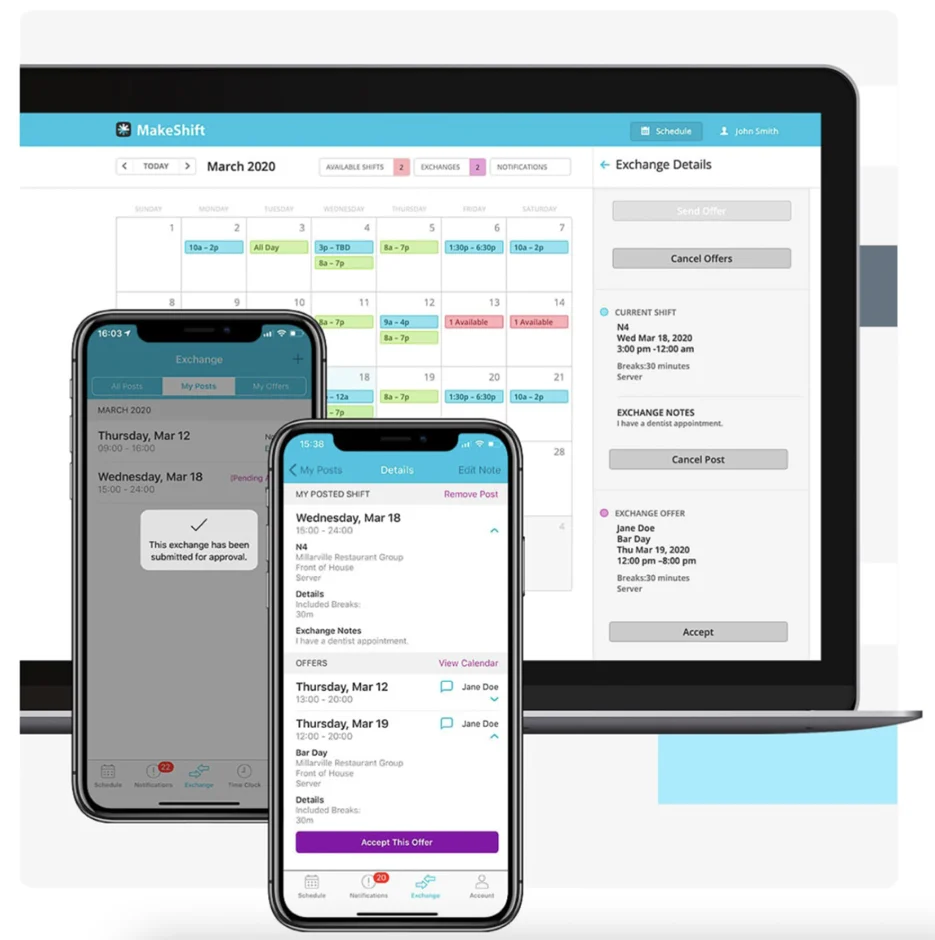
- Team communication is streamlined, and everyone stays in the loop.

- Our AI-powered scheduling platform is available 24/7
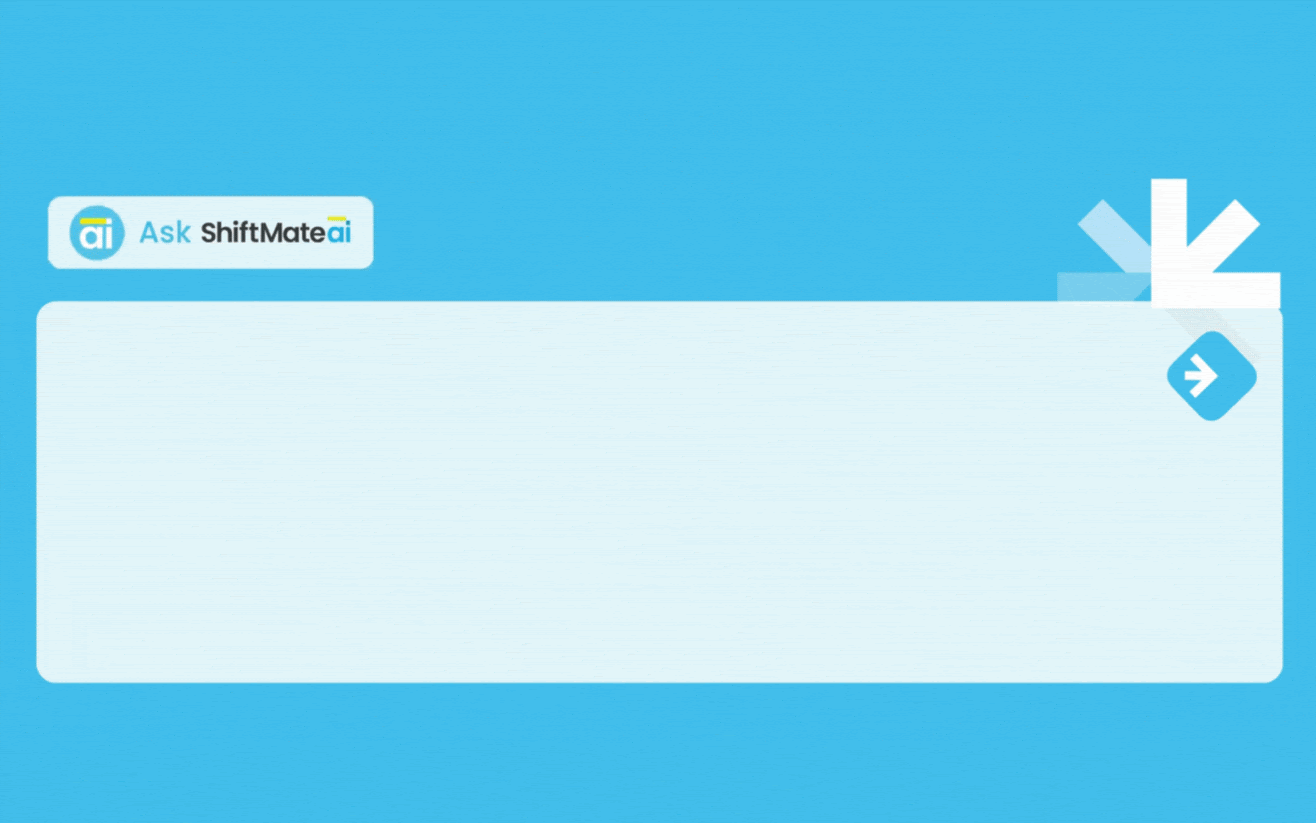
FAQs about Employee Engagement
What are the 5 C's of employee engagement?
The 5 C's of employee engagement are:
- Competence — Ensuring employees have the right skills and understanding to perform their roles effectively.
- Clarity — Providing clear expectations and understanding of roles and responsibilities.
- Confidence — Building a work environment where employees feel confident and secure in their positions.
- Congruence — Aligning the goals and values of the organization with those of the employees.
- Commitment — Encouraging a mutual sense of loyalty and dedication between the employee and the organization.
What are the 4 E's of employee engagement?
The 4 E's of employee engagement are:
- Engage — Creating a work environment where employees feel involved, respected, and connected.
- Empower — Providing employees with autonomy, resources, and opportunities to make decisions and contribute their ideas.
- Enhance — Focusing on personal and professional growth, including training and career development.
- Encourage — Recognizing and rewarding employees' efforts and achievements, fostering a culture of appreciation.
What is the significance of employee engagement?
The significance of employee engagement lies in its impact on employees and your organization. Engaged employees are generally more productive, have higher morale, and are more likely to stay with an organization, reducing turnover costs.
For your organization, high levels of engagement lead to better customer satisfaction, increased sales, higher quality of work, and overall improved financial performance.
Engaged workplaces foster innovation and strong team dynamics and are more resilient during challenging times.
Employee Engagement Must Be a Priority
If you want higher retention rates and loyal employees, focus on improving your employee engagement.
People who are passionate about their work and their company not only stick around but they go above and beyond.
MakeShift’s people-first approach to scheduling can help elevate your employee engagement through smarter scheduling. Ready to see for yourself? Schedule a FREE demo today.




